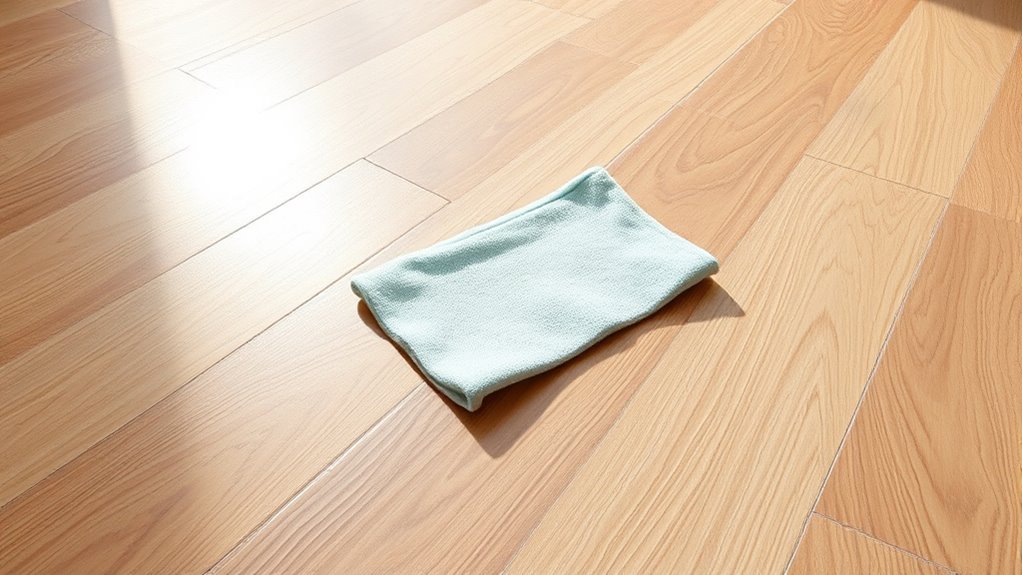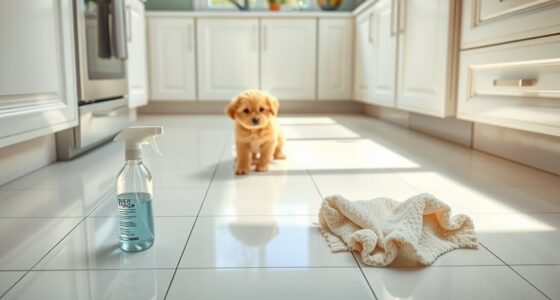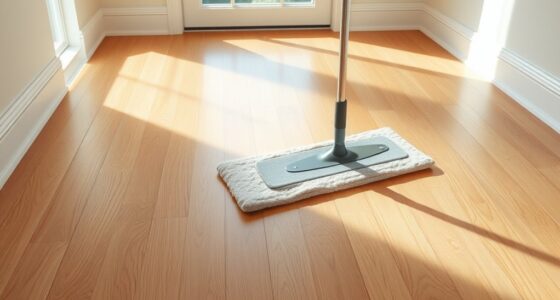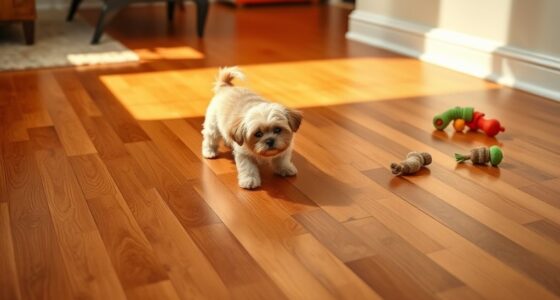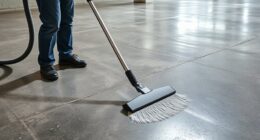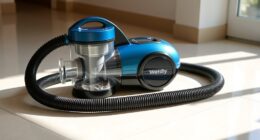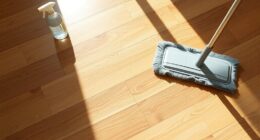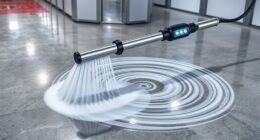To deep-clean vinyl plank (LVP) safely, start by thoroughly vacuuming to remove loose dirt and debris, using a soft brush attachment for textured areas. Next, mix warm water with a few drops of gentle dish soap and dampen a microfiber mop or cloth for gentle wiping, avoiding harsh chemicals or abrasive scrubbers. Rinse with a damp cloth and dry with a microfiber towel to prevent damage. Properly maintaining your floors helps preserve their beauty—continue for detailed steps and tips.
Key Takeaways
- Vacuum thoroughly with a soft brush attachment to remove loose dirt before wet cleaning.
- Use a diluted, gentle cleaning solution like warm water with a few drops of dish soap.
- Dampen a microfiber mop or cloth and gently clean the surface in circular motions.
- Rinse the area with a clean damp cloth to remove soap residue, avoiding excess water.
- Dry the floor completely with a microfiber cloth to prevent streaks and water damage.
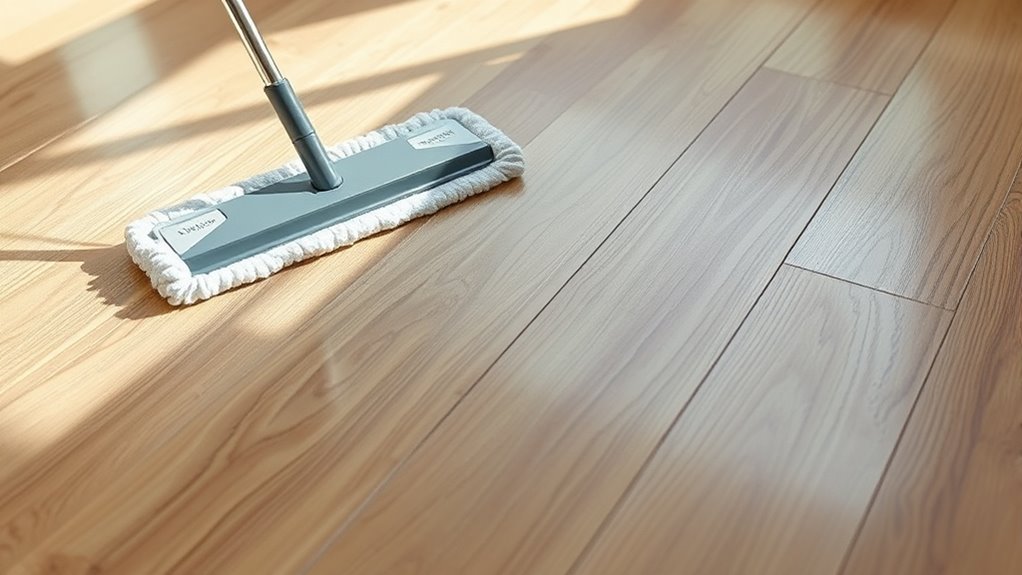
Keeping your vinyl plank (LVP) flooring looking its best requires regular deep cleaning, especially since dirt and grime can build up in the seams and textured surfaces. To guarantee your floors stay spotless without damage, start with proper vacuum maintenance. Regularly inspect and replace your vacuum cleaner’s filters and brushes to prevent scratching the surface. Use a vacuum with adjustable height and a soft brush attachment designed for hard floors. This helps remove loose dirt and debris efficiently without causing scratches or dulling the finish. Make sure to get into the seams and textured areas, where dirt tends to settle more stubbornly. This initial step is vital because it prevents dirt from being ground into the surface during wet cleaning, which might lead to scratches or dullness.
Once you’ve thoroughly vacuumed the surface, you can move on to stain removal techniques. When dealing with stains, acting quickly is key. For most spills or spots, a mixture of warm water and a few drops of gentle dish soap works well. Dampen a soft cloth or microfiber mop with this solution and gently wipe the stained area. Avoid soaking the floor, as excess moisture can seep into seams and cause damage over time. For tougher stains like ink, lipstick, or pet stains, you might need a specialized vinyl cleaner. Always test any cleaning solution on a small, inconspicuous area first to ensure it doesn’t discolor or harm the finish.
When cleaning, steer clear of abrasive scrubbers or harsh chemicals, such as bleach or ammonia, which can strip away the protective topcoat. Instead, use a soft-bristled brush or sponge for stubborn spots. For textured surfaces, you may need to gently scrub in a circular motion to lift dirt from crevices without damaging the surface. After removing stains, rinse the area with a clean, damp cloth to eliminate any residue. Dry the surface with a microfiber cloth to prevent water spots or streaks.
Additionally, understanding the importance of proper maintenance and regular inspections can significantly extend the lifespan of your vinyl plank flooring. For ongoing maintenance, keep your vacuum in good condition and regularly check the brush roll and filters. This guarantees it performs at its best and reduces the risk of scratching your vinyl plank flooring. When stains are particularly stubborn, patience and proper technique are your best tools. Consistent, gentle cleaning combined with routine vacuum maintenance and effective stain removal techniques will keep your floors looking fresh and pristine, extending their life and maintaining their beauty over time.
Frequently Asked Questions
Can I Use a Steam Mop on Vinyl Plank Flooring?
You can use steam mops on vinyl plank flooring, but you should do so cautiously. Steam mops can be convenient for deep cleaning, but excessive heat and moisture might cause vinyl damage over time. Make sure to use a low or no steam setting, and avoid letting the steam sit in one spot. Always check your flooring manufacturer’s guidelines to prevent any potential damage.
How Often Should I Deep-Clean My Vinyl Plank Floors?
Think of your vinyl plank floors as a shining treasure that needs regular care. You should deep-clean them every 4 to 6 months, depending on foot traffic and spills, to keep them pristine. Follow a consistent floor cleaning schedule and adjust your maintenance frequency if you notice dullness or grime buildup. This routine keeps your floors looking fresh and extends their lifespan, making your space feel like new each time you step on it.
Are There Any Cleaning Products I Should Avoid?
You should avoid harsh chemicals and abrasive cleaners when cleaning your vinyl plank floors. These can damage the surface, causing dullness or scratches. Stick to gentle, pH-neutral cleaners or a mix of mild soap and water. Always read labels and test a small area first. Using the right products guarantees your floors stay beautiful and undamaged, maintaining their durability and appearance for years to come.
Is It Safe to Use Bleach on Vinyl Plank Floors?
Bleach isn’t safe for vinyl plank floors because it can cause damage. Bleach safety is questionable, as it may weaken the floor’s surface and lead to discoloration or warping. Instead, stick to gentle, pH-neutral cleaners designed for vinyl flooring. If you want to disinfect, consider diluted vinegar or specialized vinyl floor cleaners, ensuring you protect your floors from potential vinyl damage caused by harsh chemicals like bleach.
Can I Use a Scrub Brush for Stubborn Stains?
Think of stubborn stains as stubborn weeds in your garden—you can’t just pull them without the right tools. Yes, you can use a scrub brush for stain removal methods, but choose one with soft bristles to avoid scratching your vinyl plank floors. Use gentle scrubbing techniques, working in a circular motion. This way, you effectively remove stains without damaging your floors, keeping them looking fresh and spotless.
Conclusion
Now that you know how to deep-clean your vinyl plank flooring without causing damage, you can keep it looking brand new. Think of your LVP as a delicate gem that needs gentle care—like watering a plant to help it thrive. Regular cleaning not only preserves its beauty but also extends its lifespan. With these simple steps, you’ll maintain a spotless, shining floor that’s as inviting as a sunny morning.
